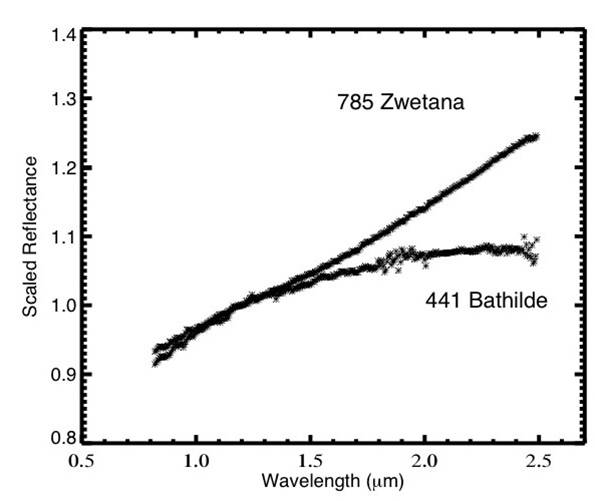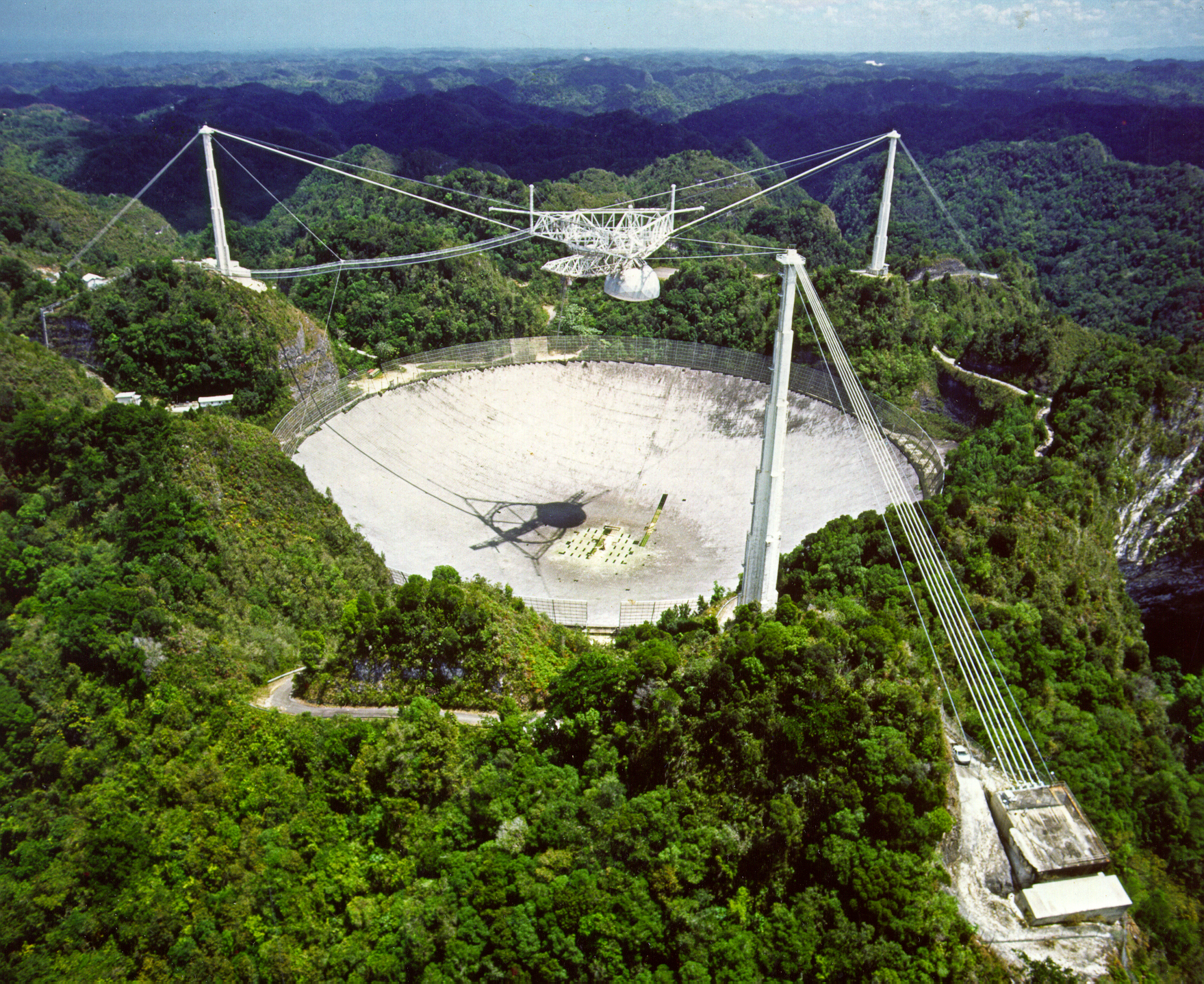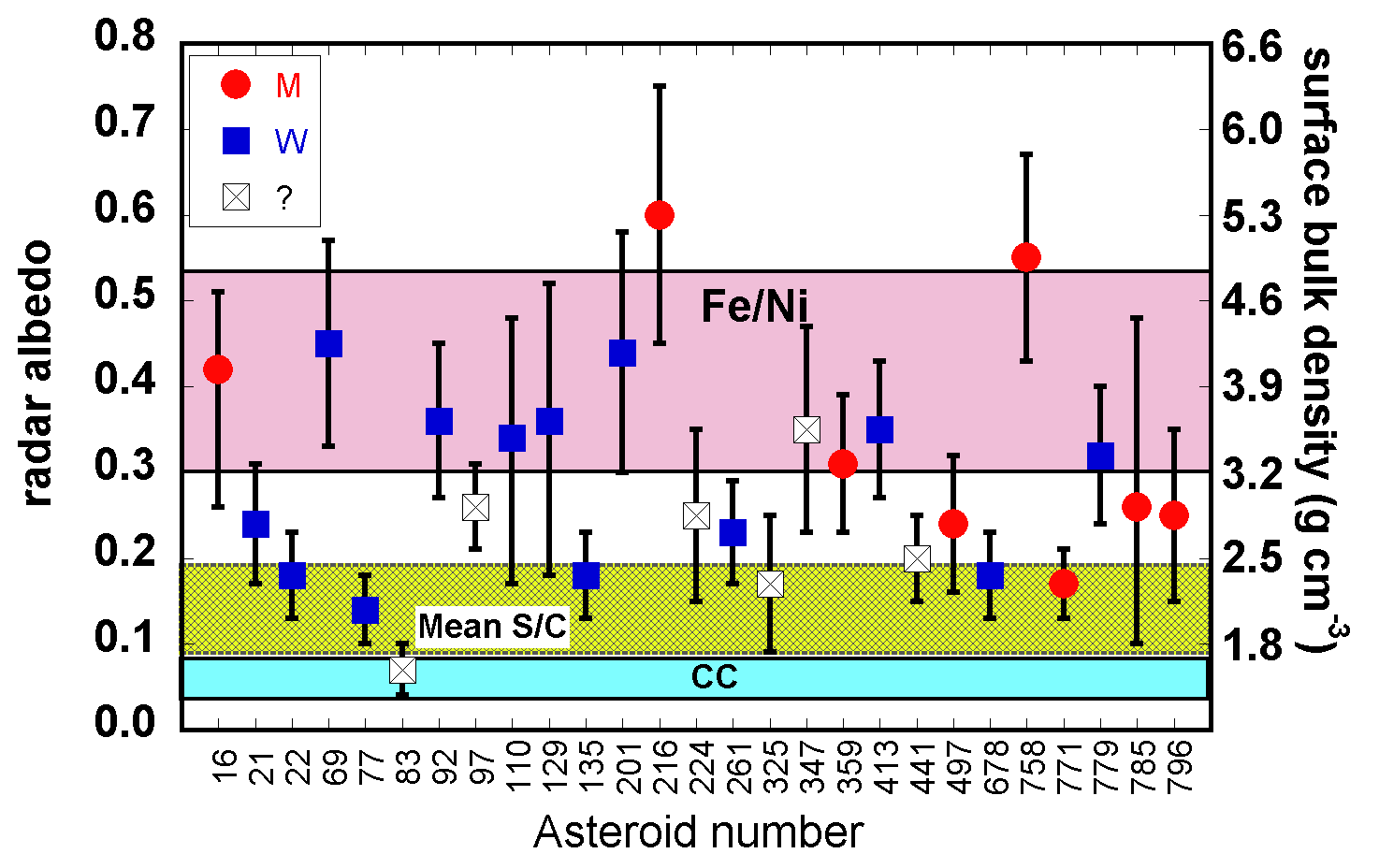
XME-Class Asteroids
X-class - What is it?
X-class asteroids are actually a supergroup of three very different asteroid classes (E, M, or P) that all have similar spectra or colors - essentially, their spectra are "red-sloped" and possess few (or no) absorption features. The figure below shows the spectra of two "typical" asteroids that fit within this class. When we don't know which of these three classes an asteroid actually belongs to, we call it X-class, as in "unknown."

.jpg)
How do we determine to which of the three an X-class should belong? In addition to its color (or spectrum), we need to know how bright it is, or more specifically, how reflective it is. We characterize an asteroid's reflectivity by its optical albedo, pv; this is the fraction of light that it reflects. Once we know this, an X-class asteroid can be more properly classified as a P, M, or E-class.
P-class asteroids are X-class with low albedos, pv < 0.1. These are thought to be primitive asteroids, perhaps with carbonaceous compounds and perhaps absorbed or adsorbed water.
E-class asteroids are X-class with high albedos, pv > 0.3. These are the optically brightest asteroids known and are traditionally thought to be enstatite achondrite - or aubrite - a highly reduced and pure iron-free enstatite.
M-class asteroids (the one's we are particularly interested in) are X-class with moderate albedos, 0.1 < pv < 0.3. These have traditionally been thought to be denuded metallic cores of ancient planetesimals or enstatite chondrite.
Why Radar?
We are primarily interested in the M-class, and to a lesser extent, the E-class. M-class have traditionally been thought to be metallic (thus the "M" designation), but - are they really? Metal spectra in the lab have similar behavior and moderate albedo, but many other materials do too, enstatite chondrites for one. We wanted to determine if these are actually metal asteroids or something else. Radar is the ideal tool to discover this because radar, unlike optical wavelengths, it very sensitive to the bulk density of the surface of the asteroid, and metal has a high bulk density. By measuring the radar albedo - the fraction of radar energy reflected back to the source - we can estimate the metal content of an asteriod. A simple detection is enough to make this determination. E-class asteroids are rare, so we decided to explore their properties whenever an opportunity presented.


Since 2004, we have been systematically observing all of the M- and E-class main-belt asteroids (those between Mars and Jupiter, the main and best characterized population) within the reach of the Arecibo radar telescope in Puerto Rico. This is the most powerful radar telescope in the world with a megawatt transmitter and a receiving dish 300m (about a fifth of a mile) across. At the time we started, we estimated that there were between 30 and 35 main-belt M-class asteroids detectable at Arecibo within the next few decades. We have detected nearly 30 so far. There were only 4 or 5 E-class objects detectable, and we have detected 3.
At the same time as the radar observations, we observed as many of these objects as possible using the NASA IRTF telescope in Hawaii. This telescope gives the visible/near-infrared spectrum of the asteroid. Our goal was to see if there was a correlation between those asteroids we found to be nearly pure metal and their optical spectrum. We can see many more objects with the IRTF than with the radar, so if we can find a correlation, we can use that to determine if other asteroids, not detectable from Arecibo, are metallic or not based on their optical spectrum.
What We've Found
Our survey suggests that only 30%-40% of the main-belt M-class asteroids are dominated by metal. The rest have more metal than your typical main-belt asteroid, but they do not appear to be the denuded cores once thought. We have suggested that the best explanation for this group is collisional remnants of metal and non-metal asteroids, similar in composition to many of the "stony-iron" meteorites.
In our most recent work, we've discovered that about half of all the M-class asteroids, including those with high metal content, appear to have OH or "hydration" features in their spectra. This is normally associated with minerals containing water and seems to be at odds with the formation mechanisms proposed for these asteroids, all of which involve a lot of heat. Based on the Dawn discovery of dark, hydrated regions on Vesta, we've suggested that the hydration features on M-class asteroids are exogenic - they were brought and deposited on the surface after the asteroid formed. This is consistent with the collisional environment of the main-belt asteroids.

(Above) All of the M-class asteroids detected with radar. The x-axis is the asteroid number. The left y-axis is the radar albedo and the right y-axis is a model estimate of the surface bulk-density represented by that radar albedo (Shepard et al. 2015). Regions of differing Fe/Ni content to silicate ratio (needed to give the associated bulk density) are color coded: the pink region represents asteroids that could be largely composed of Fe/Ni. The hatched yellow region is where the bulk of the S- and C-class asteroids are found; the blue region is very low bulk density, consistent with carbonaceous chondrite (CC) compositions. Many of the M-class reside between the yellow and pink regions, suggesting an elevated metal content. Red circles are asteroids that have no associated hydration feature (although recent evidence suggests (16) Psyche does). Blue squares are asteroids where a hydration feature was detected; open squares have not been examined for such a feature.
The E-class asteroids are odd in radar. Lance Benner (JPL) and colleagues discovered that in the near-Earth population (those asteroids that cross the orbits of the inner planets), the E-class have unusually high radar polarization ratios. This is the ratio of the power reflected in an unexpected sense of polarization (unexpected from a smooth surface) to that in the expected sense. Most asteroids have polarization ratios of ~0.05 to 0.2 or so; the higher the number, the "rougher" the surface and near surface is expected to be. Benner et al. found that the E-class have values approaching 1.0! At about the same time, we found similar behavior in the main-belt E-class asteroids. We are still attempting to figure out why this is so - what is it about the roughness, composition, or evolution of this particular class that makes them reflect radar energy so oddly?
Here are the papers we've published outlining our findings.
Shepard et al. 2015. A radar survey of M- and X-class asteroids III. Insights into their composition, hydration state, & structure. Icarus 245, pp. 38-55. doi:10.1016/j.icarus.2014.09.016
Neeley et al. 2014. The composition of M-type asteroids II: Synthesis of spectroscopic and radar observations. Icarus 238, pp. 37-50. doi:10.1016/j.icarus.2014.05.008
Rivkin et al. 2011. Asteroid 21 Lutetia at 3 micrometers: Observations with IRTF SpeX. Icarus 216, pp. 62-68. doi:10.1016/j.icarus.2011.08.009
Shepard et al. 2011. Radar observations of Asteroids 64 Angelina and 69 Hesperia. Icarus 115, pp. 547-551. doi:10.1016/j.icarus.2011.07.027
Ockert-Bell et al. 2010. The composition of M-type asteroids: Synthesis of spectroscopic and radar observations. Icarus 210, pp. 674-692. doi:10.1016/j.icarus.2010.08.002
Shepard et al. 2010. A radar survey of M- and X-class asteroids II. Summary and synthesis. Icarus 208, pp. 221-237. doi:10.1016/j.icarus.2010.01.017
Shepard et al. 2008. A radar survey of M- and X-class asteroids. Icarus 195, pp. 184-205. doi:10.1016/j.icarus.2007.11.032
Ockert-Bell et al. 2008. Observations of X/M asteroids across multiple wavelengths. Icarus 195, pp. 206-219. doi:10.1016/j.icarus.2007.11.006
Shepard et al. 2008. Radar observations of E-class Asteroids 44 Nysa and 434 Hungaria. Icarus 195, pp. 220-225. doi:10.1016/j.icarus.2007.12.018
Benner et al. 2008. Near-Earth asteroid surface roughness depends on compositional class. Icarus 198, pp. 294-304. doi:10.1016/j.icarus.2008.06.010
Acknowledgements. This work was supported by the Planetary Astronomy Division of the National Science Foundation. We are very grateful for their support.